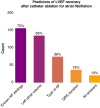Definition and management of arrhythmia-induced cardiomyopathy: findings from the European Heart Rhythm Association survey
- PMID: 38693772
- PMCID: PMC11094751
- DOI: 10.1093/europace/euae112
Definition and management of arrhythmia-induced cardiomyopathy: findings from the European Heart Rhythm Association survey
Abstract
Aims: Arrhythmia-induced cardiomyopathy (AiCM) represents a subtype of acute heart failure (HF) in the context of sustained arrhythmia. Clear definitions and management recommendations for AiCM are lacking. The European Heart Rhythm Association Scientific Initiatives Committee (EHRA SIC) conducted a survey to explore the current definitions and management of patients with AiCM among European and non-European electrophysiologists.
Methods and results: A 25-item online questionnaire was developed and distributed among EP specialists on the EHRA SIC website and on social media between 4 September and 5 October 2023. Of the 206 respondents, 16% were female and 61% were between 30 and 49 years old. Most of the respondents were EP specialists (81%) working at university hospitals (47%). While most participants (67%) agreed that AiCM should be defined as a left ventricular ejection fraction (LVEF) impairment after new onset of an arrhythmia, only 35% identified a specific LVEF drop to diagnose AiCM with a wide range of values (5-20% LVEF drop). Most respondents considered all available therapies: catheter ablation (93%), electrical cardioversion (83%), antiarrhythmic drugs (76%), and adjuvant HF treatment (76%). A total of 83% of respondents indicated that adjuvant HF treatment should be started at first HF diagnosis prior to antiarrhythmic treatment, and 84% agreed it should be stopped within six months after LVEF normalization. Responses for the optimal time point for the first LVEF reassessment during follow-up varied markedly (1 day-6 months after antiarrhythmic treatment).
Conclusion: This EHRA Survey reveals varying practices regarding AiCM among physicians, highlighting a lack of consensus and heterogenous care of these patients.
Keywords: Antwerp score; Arrhythmia-induced cardiomyopathy; Atrial fibrillation; Heart failure; Pacemaker; Premature ventricular contractions.
© The Author(s) 2024. Published by Oxford University Press on behalf of the European Society of Cardiology.
Conflict of interest statement
Conflict of interest: T.S. has received research funding from the Swiss Academy of Medical Sciences and the ‘Gottfried & Julia Bangerter-Rhyner’ Foundation. P.B. has received research funding from the ‘University of Basel’, the ‘Stiftung für Herzschrittmacher und Elektrophysiologie’, the ‘Freiwillige Akademische Gesellschaft Basel’, and Johnson&Johnson, all outside the submitted work and reports personal fees from Abbott. M.K. reports grants from Bayer, grants from BMS, grants from Boston Scientific, grants from Daiichi Sankyo, grants from Pfizer, personal fees from Abbott, personal fees from Boston Scientific, and personal fees from Daiichi Sankyo, all outside the submitted work. C.S. is a Member of Medtronic Advisory Board Europe and Boston Scientific Advisory Board Europe, received educational grants from Biosense Webster and Biotronik and a research grant from the European Union’s FP7 programme and Biosense Webster, and lecture and consulting fees from Abbott, Medtronic, Biosense-Webster, Boston Scientific, Microport, and Biotronik, all outside the submitted work J.d.F.d.L. has received research funding from the ‘University of Basel’ and from the ‘Swiss Heart Foundation’. The remaining authors have nothing to declare. The production of this document is under the responsibility of the Scientific Initiatives Committee of the European Heart Rhythm Association: Julian K.R. Chun (Chair), Sergio Castrejon (Co-Chair), Ante Anic, Giulio Conte, Piotr Futyma, Andreas Metzner, Federico Migliore, Giacomo Mugnai, Laura Perrotta, Rui Providencia, Sergio Richter, Laurent Roten, and Arian Sultan. The authors acknowledge the EHRA Scientific Research Network centres participating in this survey. A list of these centres can be found on the EHRA website.
Figures





Similar articles
-
How are arrhythmias managed in the paediatric population in Europe? Results of the European Heart Rhythm survey.Europace. 2014 Dec;16(12):1852-6. doi: 10.1093/europace/euu313. Europace. 2014. PMID: 25417228
-
Guideline-directed medical therapy for heart failure in arrhythmia-induced cardiomyopathy with improved left ventricular ejection fraction.Eur J Heart Fail. 2025 Mar;27(3):442-452. doi: 10.1002/ejhf.3556. Epub 2024 Dec 18. Eur J Heart Fail. 2025. PMID: 39694688 Free PMC article.
-
Arrhythmia-Induced Cardiomyopathy: JACC State-of-the-Art Review.J Am Coll Cardiol. 2024 Jun 4;83(22):2214-2232. doi: 10.1016/j.jacc.2024.03.416. J Am Coll Cardiol. 2024. PMID: 38811098 Review.
-
The role of the Arrhythmia Team, an integrated, multidisciplinary approach to treatment of patients with cardiac arrhythmias: results of the European Heart Rhythm Association survey.Europace. 2016 Apr;18(4):623-7. doi: 10.1093/europace/euw090. Europace. 2016. PMID: 27174994
-
Arrhythmia-Induced Cardiomyopathy: JACC State-of-the-Art Review.J Am Coll Cardiol. 2019 May 14;73(18):2328-2344. doi: 10.1016/j.jacc.2019.02.045. J Am Coll Cardiol. 2019. PMID: 31072578 Free PMC article. Review.
Cited by
-
Arrhythmia-Induced Cardiomyopathy: Predictors of Improvement in Left Ventricular Systolic Function After Catheter Ablation.J Clin Med. 2025 Feb 28;14(5):1636. doi: 10.3390/jcm14051636. J Clin Med. 2025. PMID: 40095568 Free PMC article. Review.
-
Tachycardia-induced cardiomyopathy in de novo heart failure: prevalence, short-term outcomes, and the role of guideline-directed therapy in ejection fraction improvement.Clin Res Cardiol. 2025 May 6. doi: 10.1007/s00392-025-02663-y. Online ahead of print. Clin Res Cardiol. 2025. PMID: 40327063
-
Diagnostic reliability of monitoring for premature atrial and ventricular complexes.Europace. 2024 Aug 3;26(8):euae198. doi: 10.1093/europace/euae198. Europace. 2024. PMID: 39056247 Free PMC article.
-
Practical compendium of antiarrhythmic drugs: a clinical consensus statement of the European Heart Rhythm Association of the European Society of Cardiology.Europace. 2025 Aug 4;27(8):euaf076. doi: 10.1093/europace/euaf076. Europace. 2025. PMID: 40159403 Free PMC article. Review.
-
Premature ventricular contraction-induced ventricular dysfunction in children without structural heart disease: a systematic review and meta-analysis.Europace. 2025 Aug 4;27(8):euaf167. doi: 10.1093/europace/euaf167. Europace. 2025. PMID: 40796120 Free PMC article.
References
-
- Simantirakis EN, Koutalas EP, Vardas PE. Arrhythmia-induced cardiomyopathies: the riddle of the chicken and the egg still unanswered? Europace 2012;14:466–73. - PubMed
-
- Hékimian G, Paulo N, Waintraub X, Bréchot N, Schmidt M, Lebreton G et al. Arrhythmia-induced cardiomyopathy: a potentially reversible cause of refractory cardiogenic shock requiring venoarterial extracorporeal membrane oxygenation. Heart Rhythm 2021;18:1106–12. - PubMed
-
- Raymond-Paquin A, Nattel S, Wakili R, Tadros R. Mechanisms and clinical significance of arrhythmia-induced cardiomyopathy. Canad J Cardiol 2018;34:1449–60. - PubMed
MeSH terms
LinkOut - more resources
Full Text Sources
Medical
Research Materials
Miscellaneous

